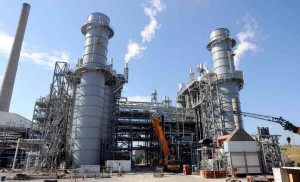 Both West Texas Intermediate and Brent crude benchmarks swung between gains and losses on Tuesday ahead of government data that may show US crude oil and gasoline stockpiles declined last week, but easing geopolitical tensions in Iraq kept gains in check. A strong dollar also weighed on oil. Natural gas advanced almost 2% as short-term weather forecasts called for a broad warm-up in the US.
Both West Texas Intermediate and Brent crude benchmarks swung between gains and losses on Tuesday ahead of government data that may show US crude oil and gasoline stockpiles declined last week, but easing geopolitical tensions in Iraq kept gains in check. A strong dollar also weighed on oil. Natural gas advanced almost 2% as short-term weather forecasts called for a broad warm-up in the US.
On the New York Mercantile Exchange, WTI crude for settlement in October traded at $93.81 per barrel at 13:46 GMT, up 0.06% on the day. Prices shifted in a daily range between $94.37 and $93.81 a barrel, close to Monday’s 8-month low of $93.42. The contract slid 1.65% yesterday to end the session at $93.75.
Meanwhile on the ICE, Brent for delivery in the same month was down 0.09% to trade at $101.51 a barrel, having ranged between $102.07 and $101.35. The European crude benchmark fell to a 14-month low of $101.11 on Monday and closed the day 1.86% lower at $101.60. Brent traded at a premium of $7.70 to its US counterpart, down from Monday’s settlement at $7.85 a barrel.
A continuously strengthening US dollar kept pressuring oil prices, but expectations that the EIA will report on Wednesday a drop in all major inventory categories helped prices grind higher.
The greenback extended gains following upbeat housing and inflation data for July, which pointed to a robust US economic recovery. The US dollar index, which measures the greenbacks performance against a basket of six major trading peers, stood at 81.895 at 13:50 GMT, up 0.33% on the day. The September contract surged to a session high of 81.900, the highest level since September 2013. Strengthening of the US dollar makes commodities priced in it more expensive for foreign currency holders and limits their appeal as an alternative investment.
Expectations for a bullish EIA report, due tomorrow, offset the effects of the strong greenback. According to a weekly Bloomberg survey ahead of the government data, crude oil inventories are expected to have declined by 1.75 million barrels in the seven days through August 15th. Gasoline stockpiles are anticipated to have dropped by 1.7 million barrels while distillate fuel supplies, which include diesel and heating oil, probably slid by 300 000 barrels. The American Petroleum Institute will release its separate private report at 20:30 GMT today.
Geopolitical tensions
Growing tension in Ukraine also provided some support. A convoy of civilians being escorted by the Ukrainian military from the towns of Khryaschuvate and Novosvitlivka was attacked with Grad rockets and mortar rounds on Monday, Ukrainian Col. Andriy Lysenko told CNN. Mr. Lysenko said that by 16:00 GMT on Monday, 15 bodies had been retrieved, with casualties including women and children.
The civilians were attempting to escape clashes between government forces and pro-Russian separatists but were not moving through an established humanitarian safety corridor when they came under fire in Ukraine’s Luhansk region.
“The convoy had white flags and was marked as civilian,” Mr Lysenko said. Ukraine accused pro-Russian separatists of attacking the convoy, but the latter have denied any involvement.
Earlier, Ukraine reported it has destroyed a column of armored vehicles entering Ukraine from Russia, while another column of rocket launchers was also seen entering rebel-controlled territory from Russia.
In the Gaza Strip, an extended ceasefire which which was set to last through Tuesday was broken as Israels military carried out air strike in response to fresh rocket fire. The truce, which had initially been negotiated for the Wednesday – Monday period was extended extended by 24 hours as Palestinian and Israeli officials held talks for a permanent solution.
Mark Regev, a spokesman for Israeli Prime Minister Benjamin Netanyahu told Reuters: “This rocket attack was a grave and direct violation of the ceasefire.”
Officials said earlier that the death toll has reached more than 2 000 Palestinians and almost 70 Israelis since Israel began its attacks on Gaza on July 8th.
Iraq
Brent slid to almost a 14-month low on Monday after Kurdish and Iraqi forces retook the Mosul dam – Iraq’s largest, with the help of U.S. air support and now need to clear a 2-kilometer stretch of mines and bombs.
President Barack Obama said yesterday that US forces have carried out 35 air strikes which allowed for the recapturing of the Mosul dam and impaired the Islamic State (IS) offensive, and will continue limited air strikes against the rebels.
Civil unrest in Iraq, OPECs second-largest producer, has so far failed to disrupt oil output in the southern parts of the country, which accounts for around three quarters of nationwide production.
Natural gas
Natural gas rose on Tuesday after hovering near a 10-month low as weather forecasting agencies called for a decent warm-up across most of the US this week, but expectations for another much larger-than-average build in nationwide inventories last week limited gains.
On the New York Mercantile Exchange, natural gas futures for settlement in September traded at $3.861 per million British thermal units at 13:50 GMT, up 1.82% on the day. Prices shifted in a daily range between $3.884 and $3.780 per mBtu. The energy source fell to a daily low of $3.727 on Monday, close to July 28th’s 9-month trough of $3.725, but rebounded and settled the day 0.42% higher at $3.792.
According to NatGasWeather.com’s August 19th – August 25th weather forecast, a large number of warmer weather systems will track across the US this week, carrying showers and thunderstorms. They will allow temperatures over the northern US to gradually rise into the upper 70s and lower 80s, boosting nationwide cooling demand to moderate compared to normal. At the same time, the southern parts of the country will remain quite hot with highs well into the 90s spreading over the Plains and Tennessee Valley. The West will also be warm but several weather systems will track through, bringing showers and cooler-than-average readings. Despite the nationwide warm-up, there will be enough weather systems carrying cooler temperatures across the US to ensure another larger-than-average build in inventories next week.
In the August 26th – September 1st time span, NatGasWeather.com projects that a Canadian system with showers, thunderstorms and below-seasonal temperatures will pass through the central US, bringing cooling demand to lower than usual. The southern and western US remain very warm with highs well into the upper 90s and lower 100s.
The strong Canadian system is expected to push through the northern Rockies this weekend and enter the central US early next week. From there on it is not sure how far it will extend to the South, but preliminary forecasts call for a fairly deep push that will bring highs over the south-central US down to the 80s from this week’s 90s. In the Northeast and Midwest, temperatures are expected to slide to the comfortable 70s, with cooling demand falling to below-usual.
Inventories
This week’s warm-up will ensure a smaller build in US gas inventories to be reported on August 28th, but it will still come in above the average levels. Market players now eye this week’s government statistics, which are expected to show a gain of over 80 billion cubic feet, narrowing the five-year deficit by another 30 bcf, or even more.





